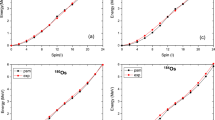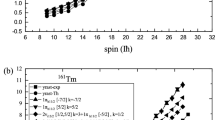Abstract
The yrast band diagram and the reduced magnetic dipole-to-electric quadruple transitions ratio, B(M1)/B(E2), are simulated using a Fortran code and constructed based on the projected shell model (PSM). Calculations using the PSM are applied to study the back-bending phenomena of neutron-rich even–even isotopes of Sm, namely \(^{150,152,154,156,158}\)Sm. The obtained B(M1) /B(E2) ratios show that around the band-crossing spin, their values are decreased. This phenomenon occurs due to a change in the structure of energy bands. Calculated results reproduce well the variation of moments of inertia as a function of rotational frequency in the presented back-bending figures for the isotopes under consideration. Finally, simulated results are compared with the available experimental data. Good agreement has been achieved from this comparison.















Similar content being viewed by others
References
K Hara and Y Sun, Int. J. Mod. Phys. E 4, 637 (1995), https://doi.org/10.1142/S0218301395000250
K Hara and Y Sun, Nucl. Phys. A 537, 77 (1992)
K Hara and Y Sun, Nucl. Phys. A 529, 445 (1991), https://doi.org/10.1016/0375-9474(91)90580-Y
R Devi, B D Sehgal, S K Khosa and J A Sheikh, Phys. Rev. C 72, 064-3041 (2005)
S Iwasaki and K Hara, Prog. Theor. Phys. 68, 1782 (1982), https://doi.org/10.1143/PTP.68.1782
A Johnson, H Ryde and J Sztarkier, Phys. Lett. B 34, 605 (1971), https://doi.org/10.1016/0370-2693(71)90150-X
F S Stephens and R S Simon, Nucl. Phys. A 183, 257 (1972), https://doi.org/10.1016/0375-9474(72)90658-6
J A Sheikh and K Hara, Phys. Rev. Lett. 82, 3968 (1999), https://doi.org/10.1103/PhysRevLett.82.3968
R Wyss and S Pilotte, Phys. Rev. C 44, R602 (1991), https://doi.org/10.1103/PhysRevC.44.R602
S Jehangir, G H Bhat, J A Sheikh, R Palit and P A Ganai, Nucl. Phys. A 968, 48 (2017), https://doi.org/10.1016/j.nuclphysa.2017.08.001
Mohamed A Al-Ammeer and Mushtaq A Hussein, J. Babylon Univ./Pure Appl. Sci. 21(2), 1432 (2013)
M Shahriarie, S Mohammadi and Z Firouzi, J. Kor. Phys. Soc. 76, 8 (2020), https://doi.org/10.3938/jkps.76.8
T Bengtsson and I Ragnarsson, Nucl. Phys. A 436, 14 (1985), https://doi.org/10.1016/0375-9474(85)90541-X
N Onishi and S Yoshida, Nucl. Phys. 80, 367 (1966), https://doi.org/10.1016/0029-5582(66)90096-4
N Onishi, R K Sheline and S Yoshida, Phys. Rev. C 2, 1304 (1970), https://doi.org/10.1103/PhysRevC.2.1304
Y Sun and K Hara, Comput. Phys. Commun. 104, 245 (1997), https://doi.org/10.1016/S0010-4655(97)00064-7
P Mollera, A J Sierka, T Ichikawab and H Sagawa, At. Data Nucl. Data Tables 109, 1 (2015), https://doi.org/10.1016/j.adt.2015.10.002
M Moonesi, A Haghpeima and M Shahriari, J. Kor. Phys. Soc. 78, 651 (2021), https://doi.org/10.1007/s40042-021-00127-w
K Hara and S Iwasaki, Nucl. Phys. A 332, 61 (1979), https://doi.org/10.1016/0375-9474(79)90094-0
J A Sheikh et al, Phys. Rev. C 77, 034313-1 (2008), https://doi.org/10.1103/PhysRevC.77.034313
Y Sun, S X Wen and D H Feng, Phys. Rev. Lett. 72, 3483 (1994), https://doi.org/10.1103/PhysRevLett.72.3483
R K Pandit, S Sharma, R Devi and S K Khosa, Eur. Phys. J. Plus 135, 830 (2020), https://doi.org/10.1140/epjp/s13360-020-00845-3
N J Stone, At. Data Nucl. Data Tables 90, 75 (2005), https://doi.org/10.1016/j.adt.2005.04.001
Y Sun and J L Egido, Nucl. Phys. A 580, 1 (1994), https://doi.org/10.1016/0375-9474(94)90811-7
Y Sun and J Egido, Nucl. Phys. A 580, 1 (1994), https://doi.org/10.1016/0375-9474(94)90811-7 (2018)
B Alex Brown, Lecture Notes in Nuclear Structure Physics, National Superconducting Cyclotron Laboratory and Department of Physics and Astronomy, Michigan 2005, sec. 4.
S Raman, C W Nestor Jr and P Tikkanen, At. Data Nucl. Data Tables 78, 1 (2001), https://doi.org/10.1006/adnd.2001.0858
B Pritychenko, M Birch, B Singh and M Horoi, At. Data Nucl. Data Tables 107, 1 (2016), https://doi.org/10.1016/j.adt.2015.10.001
S J Asztalos et al, Phys. Rev. C 60, 044307-1-1 (1999), https://doi.org/10.1103/PhysRevC.60.044306
H O Nafie, J H Madani and K A Gado, Int. J. Sci.: Basic Appl. Res. 13, 11 (2014)
R B Firestone, V S Shirley, S Y Frank chu, C M Baglin and J Zipkin, Table of isotopes 8th Edn (John Wiley and Sons, 1998)
R Devi, B D Sehgal and S K Khosa, Pramana – J. Phys. 67, 467 (2006), https://doi.org/10.1007/s12043-006-0007-z
R K Pandit, S Sharma, R Devi, S K Khosa, G H Bhat and J A Sheikh, Chin. Phys. C 43(12), 124108-1 (2019), https://doi.org/10.1088/1674-1137/43/12/124108
A Bohr and B R Mottelson, Nuclear structure (World Scientific, Singapore\(/\)New Jersey\(/\)London\(/\)Hong Kong, 1998) Vol. 1, Sec. 3
Author information
Authors and Affiliations
Corresponding author
Rights and permissions
About this article
Cite this article
Pahlavani, M.R., Teymoori, M. The projected shell model study of the reduced electromagnetic transition probability ratio and back-bending for \(A=\) 150–158 isotopes of Sm nucleus. Pramana - J Phys 96, 107 (2022). https://doi.org/10.1007/s12043-022-02353-8
Received:
Revised:
Accepted:
Published:
DOI: https://doi.org/10.1007/s12043-022-02353-8




